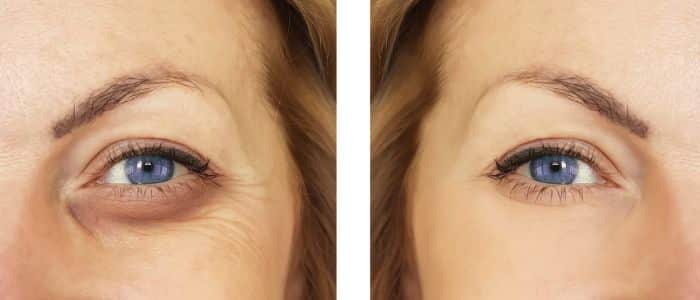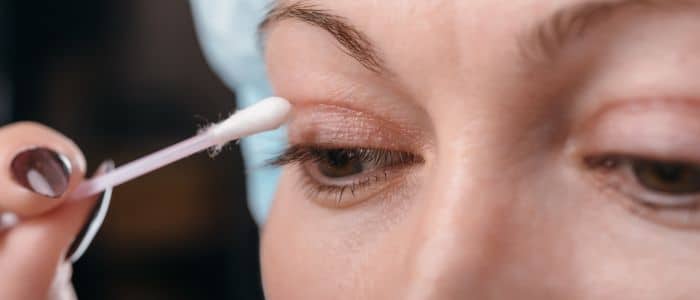
Drooping Eyelids – Causes and Effective Solutions
Eyelid ptosis is a condition characterised by the drooping of the upper eyelid. This can affect one or both eyes and varies in severity from a slight lowering that’s barely noticeable to the eyelid covering the pupil entirely, which can impair vision. People often notice this issue when it starts to interfere with their ability to see properly or when it changes the appearance of their face. The causes of this condition can be numerous, ranging from natural ageing processes to more immediate factors like injuries or medical conditions. For some, the change in appearance or the inconvenience in sight prompts a visit to a plastic surgeon. It’s essential to understand that while eyelid ptosis might be a cosmetic concern for many, its implications can extend to functional aspects, impacting daily activities.
In this blog, Chester Consultant Plastic Surgeon Anca Breahna breaks down everything you need to know about Eyelid Ptosis, from what causes it to the different ways it can be treated.
Types of Eyelid Ptosis
Eyelid ptosis can be broadly classified into two categories: congenital and acquired. Congenital ptosis is present at birth and often results from developmental issues with the muscles responsible for lifting the eyelid. In most cases, it’s identified early in a child’s life due to the noticeable droop and potential impact on vision development.
On the other hand, acquired ptosis develops later and can be due to various reasons. Ageing is a common factor, as the muscles and skin around the eyes naturally weaken over time. Other causes include trauma, such as injuries to the eye or eyelid; medical conditions, including nerve damage or diseases affecting muscle strength; and the aftermath of eye surgery, which can sometimes impact the eyelid’s muscles.
Causes of Congenital Eyelid Ptosis
Congenital eyelid ptosis is often attributed to underdevelopment of the levator palpebrae superioris, the muscle responsible for lifting the eyelid. This condition is usually noticed shortly after birth and can range in severity. In some instances, the muscle develops poorly during gestation, which leads to inadequate lift of the eyelid from the onset of life. Genetic factors can also play a significant role; the condition may run in families, indicating a hereditary predisposition.
The impact of congenital ptosis goes beyond a mere cosmetic concern. It can interfere with the development of normal vision if the drooping eyelid obstructs the visual field. This obstruction can lead to amblyopia, commonly known as lazy eye, where the vision in one eye does not develop correctly because the brain and eye are not working together as they should. Therefore, early detection and treatment are essential to ensure normal vision development in affected children.
Causes of Acquired Eyelid Ptosis
Acquired eyelid ptosis can occur at any age and arises from a variety of causes. Ageing is the most common factor, as the muscles of the eyelid, particularly the levator muscle, weaken over time. This natural weakening can lead to the eyelid gradually drooping. Trauma or injury to the eye area can also lead to ptosis if the levator muscle or its nerve supply is damaged.
Certain medical conditions may contribute to the development of ptosis. Neurological conditions that affect the muscles or nerves, such as myasthenia gravis or a third cranial nerve palsy, can result in eyelid drooping. Likewise, systemic diseases like diabetes can impact the muscles around the eyes. Surgery on or around the eye, such as cataract operations, can sometimes affect the eyelid’s position due to the manipulation of tissues or as a reaction to local anaesthesia.
Symptoms of Eyelid Ptosis
The most noticeable symptom of eyelid ptosis is the drooping of the upper eyelid. Depending on the severity, this can range from a minor droop where the eyelid covers only a small part of the eye, to a more significant one where the eyelid can cover the pupil entirely. This can lead to a reduction in the field of vision, particularly affecting the upper part. Individuals may find they have to tilt their heads back or lift their eyelids with their fingers to see clearly.
Additional symptoms may include increased tearing as the eye tries to compensate for the exposure and protect itself, and fatigue from the constant effort to raise the eyelids to see better. In some cases, the asymmetry between the eyes due to ptosis can also be quite pronounced, affecting one’s appearance.
Diagnosing Eyelid Ptosis
The process of diagnosing eyelid ptosis involves a thorough examination by a healthcare professional, often an ophthalmologist or a plastic surgeon. The examination starts with a detailed medical history to understand any underlying conditions or factors that could contribute to ptosis. Following this, a physical examination of the eyes and eyelids is conducted to assess the extent of the droop and its impact on vision.
In some cases, visual field testing is a critical component of the diagnosis. This test measures the entire scope of vision, including the peripheral vision, to determine how much the drooping eyelid is affecting the patient’s sight. For a more detailed assessment, imaging tests such as an MRI or CT scan might be recommended to rule out any underlying neurological conditions or to get a closer look at the muscles and structures of the eyelid.
In addition to these tests, Anca may perform specific measurements to evaluate the strength of the eyelid muscles, particularly the levator muscle. These measurements help in planning the appropriate treatment and determining whether surgery is a viable option.
Surgical Treatments for Congenital Ptosis
Surgical intervention for congenital eyelid ptosis is often deemed necessary due to the potential for the condition to interfere with normal vision development and to ensure the eye is adequately protected. The primary goal of surgery is to improve the eyelid’s position to enhance the patient’s field of vision and appearance. The decision to proceed with surgery, the timing, and the choice of surgical technique depend on the severity of the ptosis, the age of the patient, and the underlying cause of the condition.
Levator Muscle Shortening
One of the most common surgical treatments for congenital ptosis involves shortening the levator muscle, which is responsible for lifting the eyelid. This procedure, known as levator resection or advancement, aims to tighten the muscle and provide better lift to the eyelid. The extent of shortening required is carefully calculated based on pre-operative measurements and the degree of ptosis.
The surgery is performed under general anaesthesia, especially in children, to ensure their comfort and safety throughout the procedure. Anca makes an incision along the natural crease of the eyelid to access the levator muscle. After shortening and tightening the muscle, the incision is closed with sutures that are either absorbable or removed a few days post-surgery.
Frontalis Sling Operation
In cases where the levator muscle is weak or poorly developed, a frontalis sling operation may be recommended. This procedure involves using a sling material to connect the eyelid to the frontalis muscle on the forehead. When the frontalis muscle contracts, it lifts the brow and, through the sling, raises the eyelid. This technique leverages the strength of the forehead muscle to compensate for the weak levator muscle, providing a lifting effect to the drooping eyelid.
The sling material can be made from synthetic materials, such as silicone, or biological materials, like the patient’s own tendon. The choice of material and the specific approach depend on the surgeon’s preference and the patient’s specific needs.
Considerations and Timing for Treatment of Eyelid Ptosis
Determining the optimal time for surgery is a critical aspect of managing congenital ptosis. Early intervention is often recommended to prevent the development of amblyopia (“lazy eye”) and to promote normal visual development. However, the specific timing must be carefully considered based on the child’s age, health, and the severity of the ptosis.
Surgical Treatments for Acquired Ptosis
Surgical treatments for acquired ptosis are tailored to address the specific cause of the drooping eyelid and the severity of the condition. Since acquired ptosis can result from a variety of factors, including ageing, muscle or nerve damage, or previous surgeries, the chosen surgical approach aims to correct the underlying issue to restore both function and aesthetics to the eyelid. The primary surgical options include levator aponeurosis repair and Muller muscle contraction surgery, each suited to different types of ptosis.
Levator Aponeurosis Repair
Levator aponeurosis repair is the most common surgical procedure for correcting acquired ptosis, particularly when the cause is the stretching or disinsertion of the levator aponeurosis, which is often related to ageing. This surgery involves reattaching or tightening the aponeurosis—the tendon-like extension of the levator muscle—to the tarsal plate of the eyelid, which provides the necessary lift to the drooping eyelid.
Performed under local anaesthesia with sedation, this procedure allows for the adjustment of the eyelid height and contour during surgery, ensuring that the desired outcome is achieved. Anca makes a small incision along the natural crease of the upper eyelid to access the levator muscle and aponeurosis. After the necessary adjustments are made, the incision is closed with fine sutures, which are usually removed within a week. The result is a more natural eyelid position, improved vision, and a more alert appearance.
Muller Muscle Contraction Surgery
For patients with milder forms of ptosis and good levator muscle function, Muller muscle contraction surgery may be recommended. This less invasive procedure targets the Muller muscle, a secondary muscle that assists in lifting the eyelid. By tightening this muscle, a subtle lift is achieved, which can be sufficient for cases where only a slight correction is needed.
This surgery is often performed from the inside of the eyelid, leaving no visible scar. It’s usually done under local anaesthesia and involves making a small incision or applying a suture to contract the Muller muscle, providing an immediate improvement in eyelid position. The recovery time is generally shorter than that of levator aponeurosis repair, with minimal discomfort and swelling.
Risks and Complications of Eyelid Ptosis Surgery
Like any surgical procedure, eyelid ptosis surgery comes with potential risks and complications. Common concerns include infection, bleeding, and reaction to anaesthesia. More specific to ptosis surgery are risks such as asymmetry between the two eyelids, overcorrection leading to difficulties in closing the eye completely, or under correction requiring further surgery.
You might also experience temporary side effects such as bruising, swelling, and discomfort around the eyes. While rare, more severe complications can include damage to the eye or changes in vision. It’s important for you to discuss these risks thoroughly with Anca prior to surgery to have a clear understanding of the potential outcomes and how risks can be minimised.
Recovery and Care Post-Surgery
The recovery process from eyelid ptosis surgery varies among individuals but generally involves a period of rest, followed by a gradual return to normal activities. Immediately after the surgery, you may experience swelling, bruising, and discomfort, which can be managed with cold compresses and prescribed pain relief.
Patients are usually advised to keep their head elevated for several days to reduce swelling and to avoid any activities that could strain the eyes, such as reading, using computers, or watching television. Stitches, if used, are typically removed within a week after surgery.
Follow-up appointments are also important to monitor the healing process and to ensure that the eyelid is healing correctly and functioning well. It may take several weeks to several months for the final results of the surgery to be fully apparent.
FAQs about Causes and Treatment for Eyelid Ptosis
Can eyelid ptosis correct itself over time, especially in infants?
- In some infants born with mild congenital ptosis, the condition can improve as they grow and their facial structures develop. However, this is not always the case, and many children will require treatment to correct the ptosis to prevent vision development issues. It’s important for infants with ptosis to be monitored regularly by a healthcare professional to decide if and when treatment is necessary.
Are there any lifestyle changes I can make to prevent or improve eyelid ptosis?
- While you cannot prevent all forms of eyelid ptosis, especially those due to ageing or genetics, maintaining a healthy lifestyle can support overall skin and muscle tone. This includes regular exercise, a balanced diet rich in vitamins and antioxidants, proper hydration, and adequate sleep. Avoiding smoking is also beneficial as it can accelerate the ageing process, affecting the skin and muscles around the eyes.
How long does recovery from eyelid ptosis surgery usually take, and are there any restrictions during this period?
- Recovery time varies among individuals, but most people can return to their normal activities within a week to 10 days, with some restrictions. Patients are generally advised to avoid strenuous activities, heavy lifting, and swimming for at least a few weeks. It’s also recommended to protect the eyes from direct sunlight and wind by wearing sunglasses. Following Anca’s post-operative care instructions is essential for a smooth recovery.
Can eyelid ptosis recur after surgery?
- Yes, there is a possibility of ptosis recurrence after surgery. The likelihood depends on various factors, including the original cause of the ptosis, the type of surgery performed, and the patient’s age and overall health. Regular follow-up appointments with Anca are important to monitor for any signs of recurrence and address them promptly.
Further Reading about Eyelid Surgery with Chester Consultant Plastic Surgeon Anca Breahna
- Read more about Recovery after Eyelid Surgery
- Read more about How to Reduce Swelling and Bruising after Blepharoplasty Surgery
- Read more about Beginners Guide to Eyelid Surgery
- Read more about What Are Hooded Eyelids?
- Read more about Solutions for Saggy Eyelids
Medical References about Eyelid Ptosis
- Eyelid ptosis – PubMed
- Ptosis (Eyelid) – an overview – Science Direct
- Droopy eyelid (ptosis): Causes, risk factors, and treatment – Medical News Today
- Ptosis (Droopy Eyelid): Causes & Treatment – Cleveland Clinic
- Environmental Factors That Contribute to Upper Eyelid Ptosis – Oxford Academic



 Ms Anca Breahna, PhD, MSc, FEBOPRAS, FRCS (Plast) is a highly regarded Consultant Plastic Surgeon specialising in the field of Aesthetic and Reconstructive Plastic Surgery. Anca performs a range of breast, body and face surgery and minor skin procedures.
Ms Anca Breahna, PhD, MSc, FEBOPRAS, FRCS (Plast) is a highly regarded Consultant Plastic Surgeon specialising in the field of Aesthetic and Reconstructive Plastic Surgery. Anca performs a range of breast, body and face surgery and minor skin procedures.